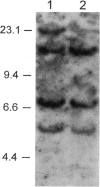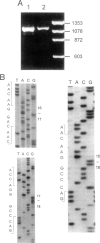Abstract
The type VI variant of the Ehlers-Danlos syndrome (EDS) is a recessively inherited connective tissue disorder which, in most families, is due to a deficiency in lysyl hydroxylase activity. We have recently characterized a homozygous duplication of 8.9 kb in the lysyl hydroxylase gene (PLOD) in two EDS VI families. The duplication is caused by a homologous recombination of Alu sequences in introns 9 and 16. Using PCR, we have analyzed 26 additional EDS VI families from various countries and found that 7 of them have this duplication. Our data has shown a frequency of 19.1% for this mutant allele among 35 EDS VI families studied by us so far. Our haplotype analysis shows a variation in the sequence of DNA region surrounding the duplication. There is an association between a particular allele size class, the long form, at the dinucleotide repeat within intron 16 and the duplication mutation in PLOD. Screening of a general population revealed one positive finding among 582 alleles tested. An abnormal sequence in exon 17 of the gene, which generated a stop codon in the exon sequence and aberrant mRNA processing, was responsible for the nonfunctionality of the other allele in one of the compound heterozygous patients.
Full text
PDF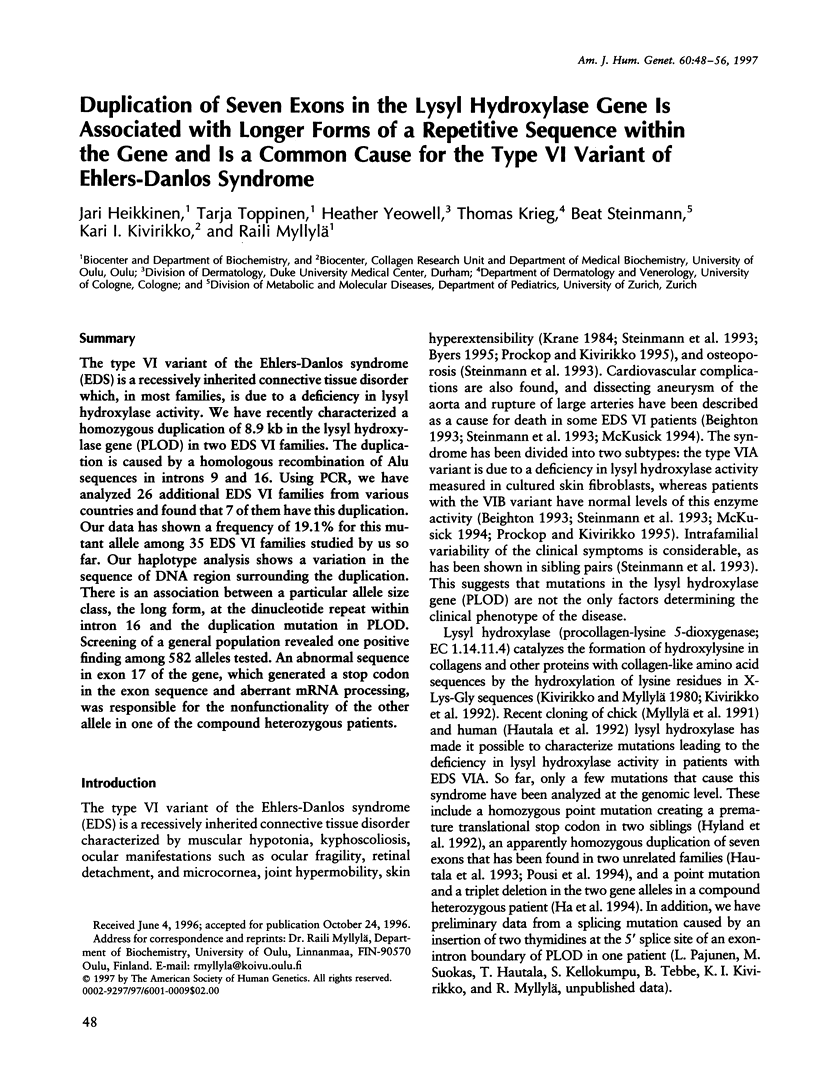
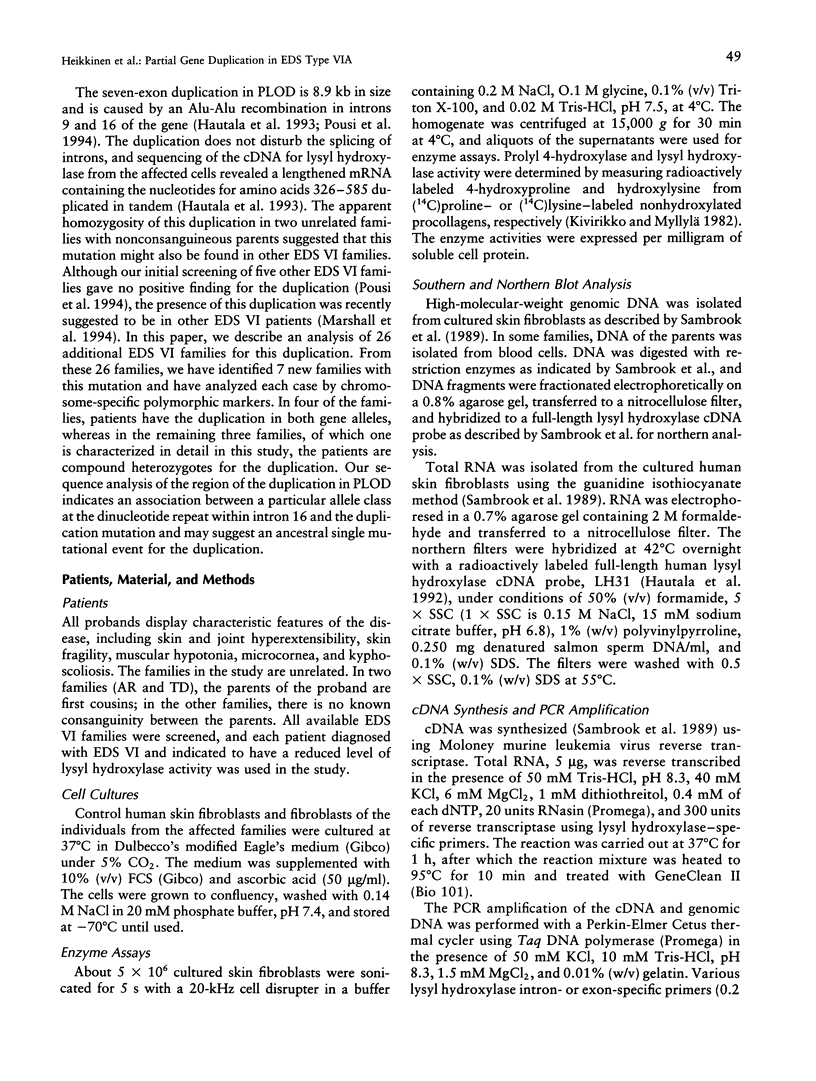
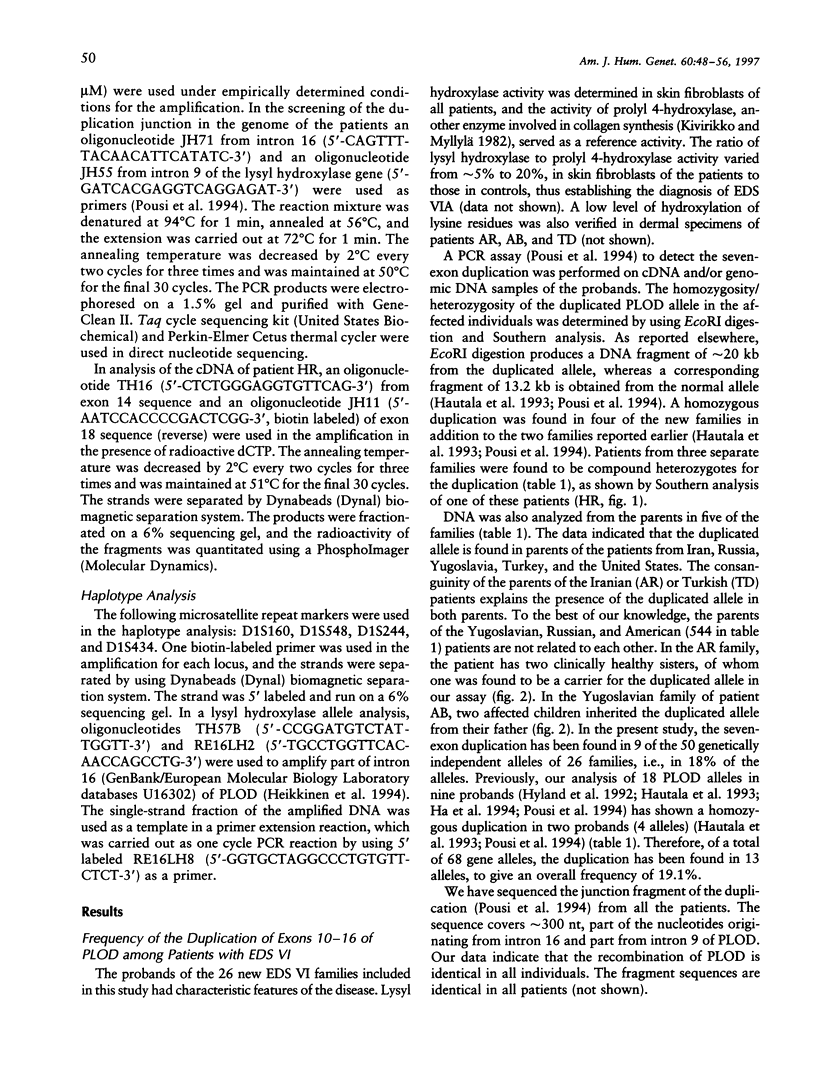
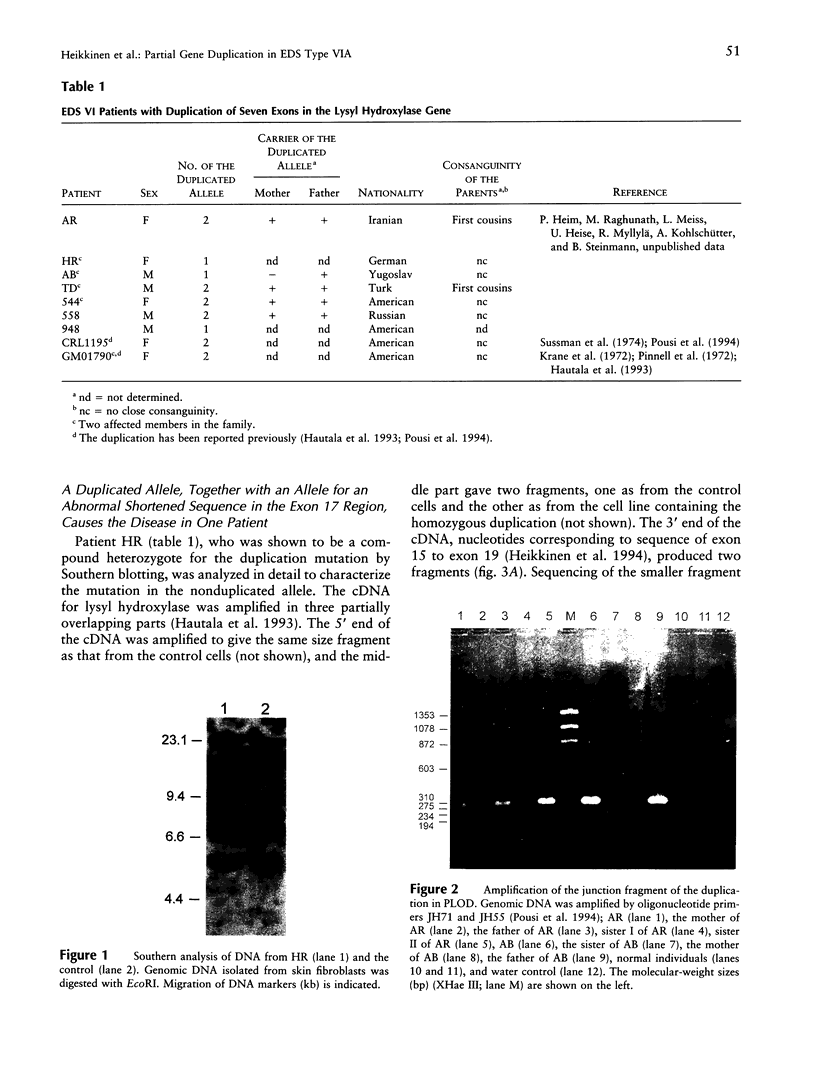
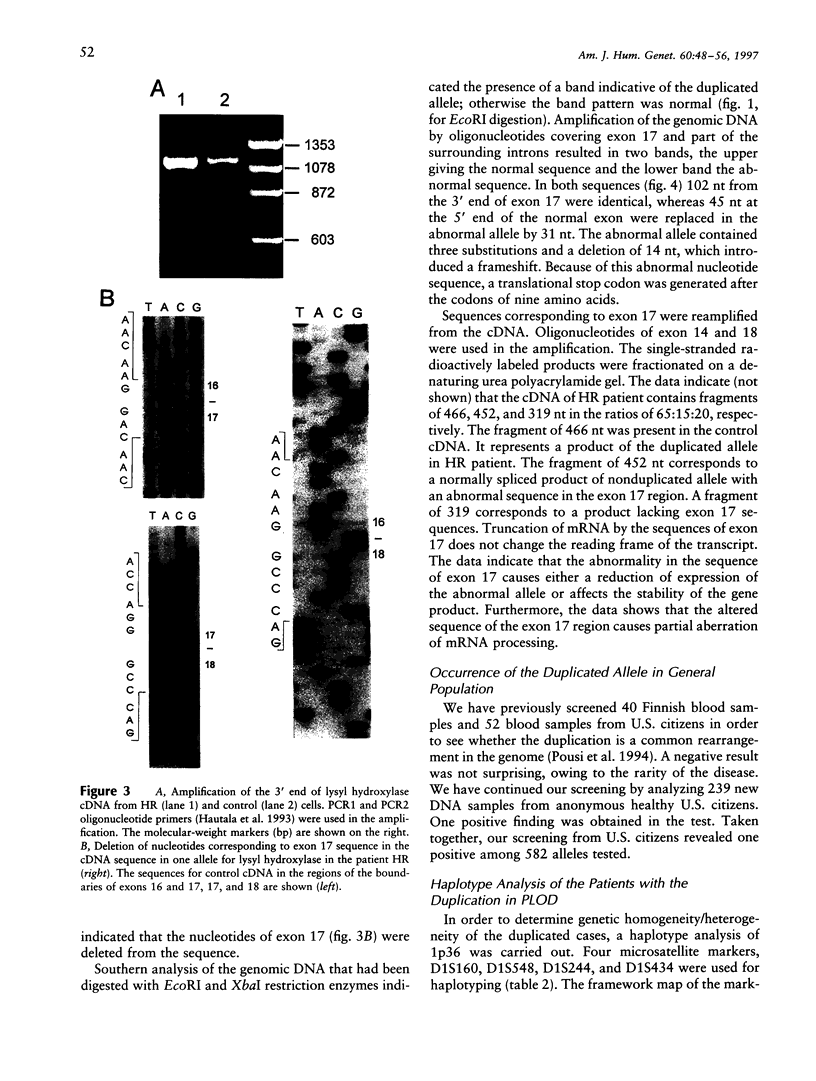
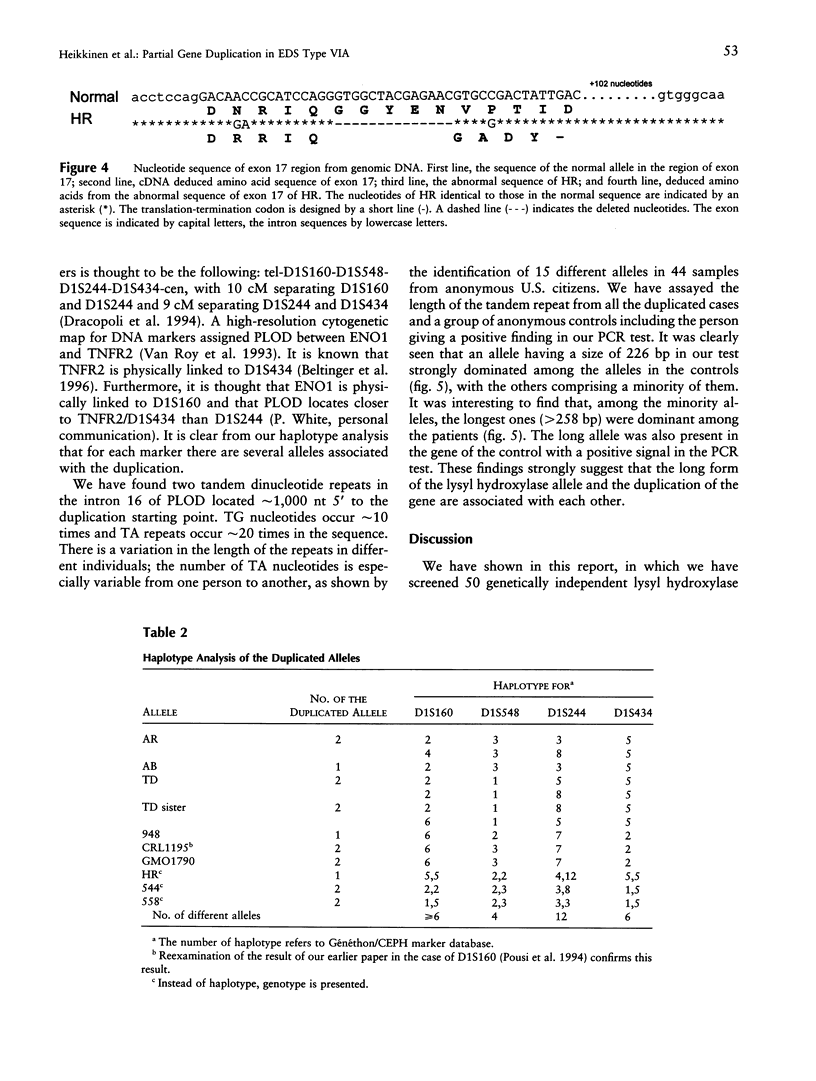
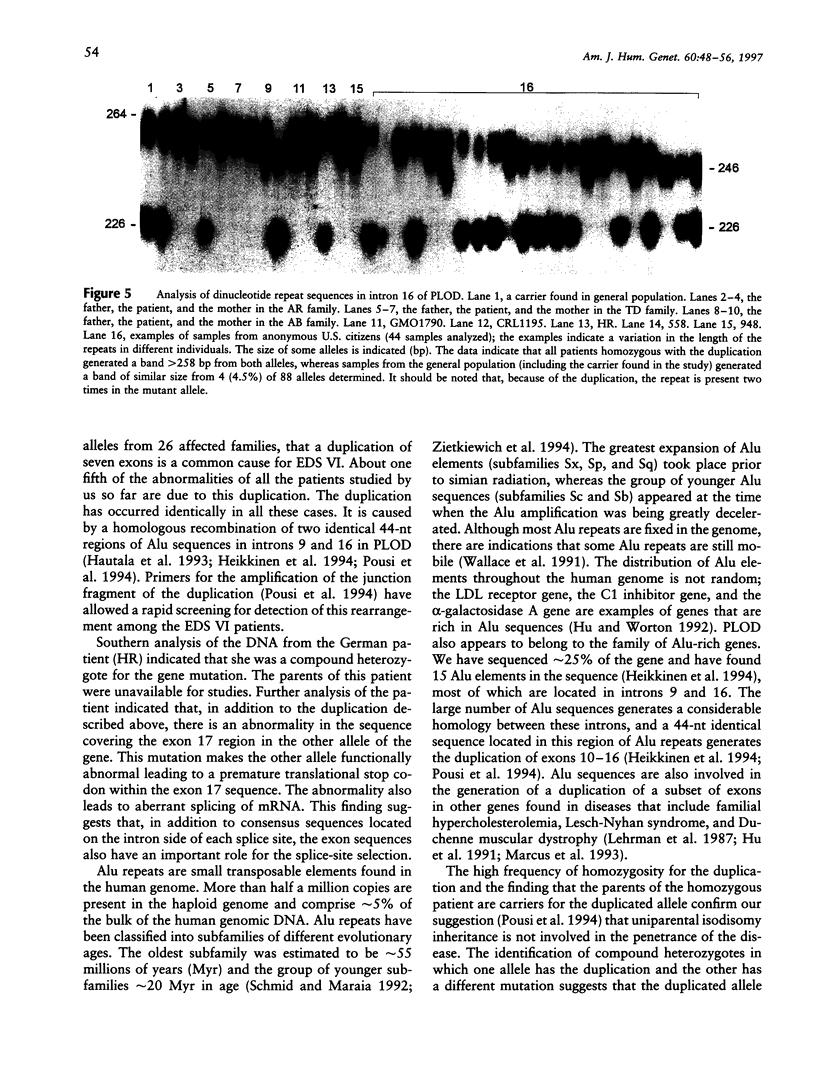
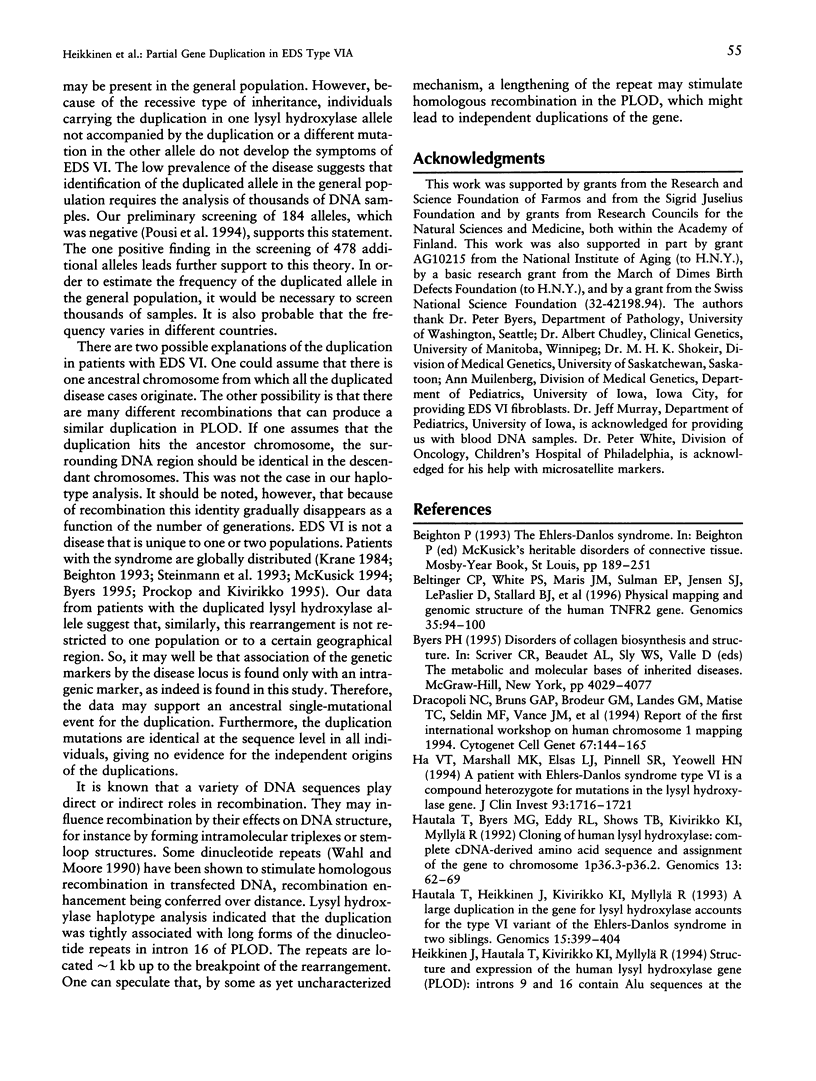
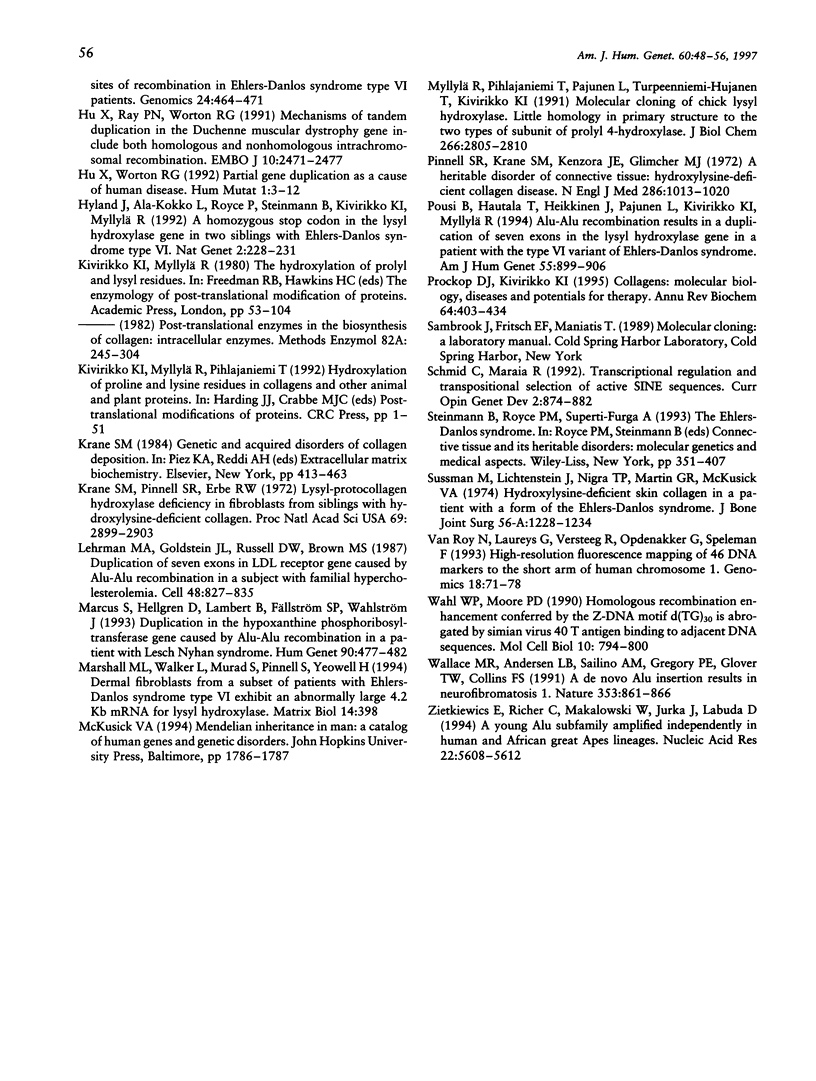
Images in this article
Selected References
These references are in PubMed. This may not be the complete list of references from this article.
- Beltinger C. P., White P. S., Maris J. M., Sulman E. P., Jensen S. J., LePaslier D., Stallard B. J., Goeddel D. V., de Sauvage F. J., Brodeur G. M. Physical mapping and genomic structure of the human TNFR2 gene. Genomics. 1996 Jul 1;35(1):94–100. doi: 10.1006/geno.1996.0327. [DOI] [PubMed] [Google Scholar]
- Dracopoli N. C., Bruns G. A., Brodeur G. M., Landes G. M., Matise T. C., Seldin M. F., Vance J. M., Weith A. Report and abstracts of the First International Workshop on Human Chromosome 1 Mapping 1994. Bethesda, Maryland, March 25-27, 1994. Cytogenet Cell Genet. 1994;67(3):144–165. [PubMed] [Google Scholar]
- Ha V. T., Marshall M. K., Elsas L. J., Pinnell S. R., Yeowell H. N. A patient with Ehlers-Danlos syndrome type VI is a compound heterozygote for mutations in the lysyl hydroxylase gene. J Clin Invest. 1994 Apr;93(4):1716–1721. doi: 10.1172/JCI117155. [DOI] [PMC free article] [PubMed] [Google Scholar]
- Hautala T., Byers M. G., Eddy R. L., Shows T. B., Kivirikko K. I., Myllylä R. Cloning of human lysyl hydroxylase: complete cDNA-derived amino acid sequence and assignment of the gene (PLOD) to chromosome 1p36.3----p36.2. Genomics. 1992 May;13(1):62–69. doi: 10.1016/0888-7543(92)90202-4. [DOI] [PubMed] [Google Scholar]
- Hautala T., Heikkinen J., Kivirikko K. I., Myllylä R. A large duplication in the gene for lysyl hydroxylase accounts for the type VI variant of Ehlers-Danlos syndrome in two siblings. Genomics. 1993 Feb;15(2):399–404. doi: 10.1006/geno.1993.1074. [DOI] [PubMed] [Google Scholar]
- Hu X. Y., Ray P. N., Worton R. G. Mechanisms of tandem duplication in the Duchenne muscular dystrophy gene include both homologous and nonhomologous intrachromosomal recombination. EMBO J. 1991 Sep;10(9):2471–2477. doi: 10.1002/j.1460-2075.1991.tb07786.x. [DOI] [PMC free article] [PubMed] [Google Scholar]
- Hu X., Worton R. G. Partial gene duplication as a cause of human disease. Hum Mutat. 1992;1(1):3–12. doi: 10.1002/humu.1380010103. [DOI] [PubMed] [Google Scholar]
- Hyland J., Ala-Kokko L., Royce P., Steinmann B., Kivirikko K. I., Myllylä R. A homozygous stop codon in the lysyl hydroxylase gene in two siblings with Ehlers-Danlos syndrome type VI. Nat Genet. 1992 Nov;2(3):228–231. doi: 10.1038/ng1192-228. [DOI] [PubMed] [Google Scholar]
- Krane S. M., Pinnell S. R., Erbe R. W. Lysyl-protocollagen hydroxylase deficiency in fibroblasts from siblings with hydroxylysine-deficient collagen. Proc Natl Acad Sci U S A. 1972 Oct;69(10):2899–2903. doi: 10.1073/pnas.69.10.2899. [DOI] [PMC free article] [PubMed] [Google Scholar]
- Lehrman M. A., Goldstein J. L., Russell D. W., Brown M. S. Duplication of seven exons in LDL receptor gene caused by Alu-Alu recombination in a subject with familial hypercholesterolemia. Cell. 1987 Mar 13;48(5):827–835. doi: 10.1016/0092-8674(87)90079-1. [DOI] [PubMed] [Google Scholar]
- Marcus S., Hellgren D., Lambert B., Fällström S. P., Wahlström J. Duplication in the hypoxanthine phosphoribosyl-transferase gene caused by Alu-Alu recombination in a patient with Lesch Nyhan syndrome. Hum Genet. 1993 Jan;90(5):477–482. doi: 10.1007/BF00217444. [DOI] [PubMed] [Google Scholar]
- Myllylä R., Pihlajaniemi T., Pajunen L., Turpeenniemi-Hujanen T., Kivirikko K. I. Molecular cloning of chick lysyl hydroxylase. Little homology in primary structure to the two types of subunit of prolyl 4-hydroxylase. J Biol Chem. 1991 Feb 15;266(5):2805–2810. [PubMed] [Google Scholar]
- Pinnell S. R., Krane S. M., Kenzora J. E., Glimcher M. J. A heritable disorder of connective tissue. Hydroxylysine-deficient collagen disease. N Engl J Med. 1972 May 11;286(19):1013–1020. doi: 10.1056/NEJM197205112861901. [DOI] [PubMed] [Google Scholar]
- Pousi B., Hautala T., Heikkinen J., Pajunen L., Kivirikko K. I., Myllylä R. Alu-Alu recombination results in a duplication of seven exons in the lysyl hydroxylase gene in a patient with the type VI variant of Ehlers-Danlos syndrome. Am J Hum Genet. 1994 Nov;55(5):899–906. [PMC free article] [PubMed] [Google Scholar]
- Prockop D. J., Kivirikko K. I. Collagens: molecular biology, diseases, and potentials for therapy. Annu Rev Biochem. 1995;64:403–434. doi: 10.1146/annurev.bi.64.070195.002155. [DOI] [PubMed] [Google Scholar]
- Schmid C., Maraia R. Transcriptional regulation and transpositional selection of active SINE sequences. Curr Opin Genet Dev. 1992 Dec;2(6):874–882. doi: 10.1016/s0959-437x(05)80110-8. [DOI] [PubMed] [Google Scholar]
- Sussman M., Lichtenstein J. R., Nigra T. P., Martin G. R., McKusick V. A. Hydroxylysine-deficient skin collagen in a patient with a form of the Ehlers-Danlos syndrome. J Bone Joint Surg Am. 1974 Sep;56(6):1228–1234. [PubMed] [Google Scholar]
- Van Roy N., Laureys G., Versteeg R., Opdenakker G., Speleman F. High-resolution fluorescence mapping of 46 DNA markers to the short arm of human chromosome 1. Genomics. 1993 Oct;18(1):71–78. doi: 10.1006/geno.1993.1427. [DOI] [PubMed] [Google Scholar]
- Wahls W. P., Moore P. D. Homologous recombination enhancement conferred by the Z-DNA motif d(TG)30 is abrogated by simian virus 40 T antigen binding to adjacent DNA sequences. Mol Cell Biol. 1990 Feb;10(2):794–800. doi: 10.1128/mcb.10.2.794. [DOI] [PMC free article] [PubMed] [Google Scholar]
- Wallace M. R., Andersen L. B., Saulino A. M., Gregory P. E., Glover T. W., Collins F. S. A de novo Alu insertion results in neurofibromatosis type 1. Nature. 1991 Oct 31;353(6347):864–866. doi: 10.1038/353864a0. [DOI] [PubMed] [Google Scholar]
- Zietkiewicz E., Richer C., Makalowski W., Jurka J., Labuda D. A young Alu subfamily amplified independently in human and African great apes lineages. Nucleic Acids Res. 1994 Dec 25;22(25):5608–5612. doi: 10.1093/nar/22.25.5608. [DOI] [PMC free article] [PubMed] [Google Scholar]



